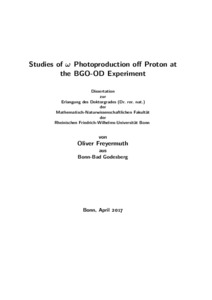Studies of ω Photoproduction off Proton at the BGO-OD Experiment

Studies of ω Photoproduction off Proton at the BGO-OD Experiment

| dc.contributor.advisor | Klein, Friedrich | |
| dc.contributor.author | Freyermuth, Oliver | |
| dc.date.accessioned | 2020-04-24T09:14:54Z | |
| dc.date.available | 2020-04-24T09:14:54Z | |
| dc.date.issued | 21.09.2017 | |
| dc.identifier.uri | https://hdl.handle.net/20.500.11811/7263 | |
| dc.description.abstract | Hadrons are composite particles which experience a mutual, non-fundamental interaction, i.e. the same force responsible for keeping protons and neutrons bound together within the atomic nucleus. This hadronic interaction and the way how hadrons are produced are under experimental investigation since several decades and are not fully understood yet. The newly installed BGO-OD experiment aims to study the mechanisms responsible for the 'photo-production' of hadrons (i.e. production induced via a photon beam). The production of vector mesons, which are hadrons with spin '1', and of hadrons with strangeness are the major processes of interest at BGO-OD. A research programme on the photoproduction of one of the lightest vector mesons, the ω, has been proposed by the BGO-OD collaboration to the physics advisory committee (PAC) of ELSA in 2012. The BGO-OD experiment has been set up at the ELSA electron accelerator facility in Bonn. It uses a bremsstrahlung-produced photon beam whose polarization can be tuned. The photons impinge on a proton target, which is surrounded by a central, electromagnetic calorimeter covering almost the full solid angle. A magnetic spectrometer is attached in the forward direction to reconstruct the momentum of forward going charged particles. It is complemented by time of flight walls to measure the relativistic speed β and provide particle identification. Furthermore, the experiment is equipped with a very open hardware trigger which allows to acquire events for different physics proposals simultaneously. This thesis is part of the endeavour to take the BGO-OD setup into operation. Along this project, technical preparation work has been performed focusing on the improvement of the time resolution requested for all detector components. It encompasses the technique for the time alignment of the detector signals to define the trigger conditions and the procedures for the time calibration, which now allow for a full control of the time information for the complete set of almost 6000 channels. Two scintillator walls for time of flight measurement have been installed and commissioned. They are equipped with a new readout electronics which was tested and implemented in the course of this thesis and allowed to improve the identification of forward going charged particles. In parallel to the improvement of the time resolution performances of the BGO-OD setup, a significant effort has been put into the development of software tools for general use by the full collaboration. These addons are covering common analysis tasks such as the selection or rejection of events and the visualization of physics observables. Furthermore, the processing of the data in multiple stages has been embedded in the analysis framework such that it is now possible to start from a common, pre-processed and reduced dataset. Finally, based on data recorded in 2015 with not yet fully completed commissioning of the BGO-OD setup, a first reconstruction of ω photoproduction events is attempted. As a cross-check of the quality of the collected data and of the software procedure, the same dataset is also used for the reconstruction and analysis of π0 photoproduction events, this reaction being the best known photoproduction process nowadays. While the results for the π0 channel show good agreement with published data within the statistical uncertainties, the results obtained for the analysis of ω photoproduction indicate that the existing setup is still inappropriate to study the photoproduction of the ω meson. Only if the full setup is brought into operation, and the angular resolution expected within the vector mesons' proposal is achieved, a better discrimination between ω photoproduction events and competing background channels could allow to perform the proposed measurements. | en |
| dc.language.iso | eng | |
| dc.rights | In Copyright | |
| dc.rights.uri | http://rightsstatements.org/vocab/InC/1.0/ | |
| dc.subject | Photoproduktion | |
| dc.subject | Meson | |
| dc.subject | Vektormeson | |
| dc.subject | ELSA | |
| dc.subject | Flugzeitmessung | |
| dc.subject | Framework | |
| dc.subject | photoproduction | |
| dc.subject | vector meson | |
| dc.subject | Time of Flight | |
| dc.subject.ddc | 530 Physik | |
| dc.title | Studies of ω Photoproduction off Proton at the BGO-OD Experiment | |
| dc.type | Dissertation oder Habilitation | |
| dc.publisher.name | Universitäts- und Landesbibliothek Bonn | |
| dc.publisher.location | Bonn | |
| dc.rights.accessRights | openAccess | |
| dc.identifier.urn | https://nbn-resolving.org/urn:nbn:de:hbz:5n-48397 | |
| ulbbn.pubtype | Erstveröffentlichung | |
| ulbbnediss.affiliation.name | Rheinische Friedrich-Wilhelms-Universität Bonn | |
| ulbbnediss.affiliation.location | Bonn | |
| ulbbnediss.thesis.level | Dissertation | |
| ulbbnediss.dissID | 4839 | |
| ulbbnediss.date.accepted | 25.07.2017 | |
| ulbbnediss.institute | Mathematisch-Naturwissenschaftliche Fakultät : Fachgruppe Physik/Astronomie / Physikalisches Institut (PI) | |
| ulbbnediss.fakultaet | Mathematisch-Naturwissenschaftliche Fakultät | |
| dc.contributor.coReferee | Desch, Klaus |
Files in this item
This item appears in the following Collection(s)
-
E-Dissertationen (4350)




